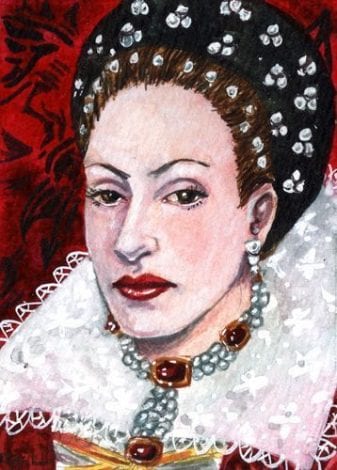Vampires are in, and Valentine’s Day has become yet another excuse to celebrate them.

Elizabeth Bathory de Ecsed, a sixteenth century Austrian countess, is said to have murdered more than 650 young women, supposedly bathing in their blood to keep her skin youthful and vigorous.
But as amorous and bloodthirsty as today’s vampires are, none compare to the “Blood Countess”, aka Countess Elizabeth Bathory de Ecsed, a sixteenth century Austrian countess who is said to have murdered more than 650 young women, supposedly bathing in their blood to keep her skin youthful and vigorous.
Countess Bathory was born in 1560 into a noble family, her father’s brother was the Voivod of Transylvania and her mother was related to the King of Poland. She spent her childhood in a castle, learning Latin, German and Greek and at age 15 was married to Ferenc Nadasdy. There were 4,500 guests at the wedding. The couple moved to a castle in western Hungary but Nadasdy spent much of his time in Vienna and later became a chief commander in the Hungarian army. Countess Bathory gave birth to five children, two of which died young. In 1604, her husband died from a battlefield injury. At around the same time a Lutheran minister named Istvan Magyari came forward with complaints about atrocities being committed by the countess. The Hungarian authorities responded slowly, a trial of a noblewoman would be scandalous. Finally in 1610 an investigation commenced. Four of Bathory’s servants were accused of being accomplices and brought to trial. The countess was merely put under house arrest.
According to several witnesses at the trial some of the earliest victims were adolescent daughters of local peasants. Countess Bathory lured them to the castle with offers of well-paid maidservant work. Later she began to kill daughters of the gentry, whose parents sent them to her gynaeceum to learn courtly etiquette. The methods of killing were described in detail, though much of it was based on hearsay. Women were beaten over extended periods of time, which often resulted in death. Hands were burnt or mutilated, sometimes also faces and genitalia. Flesh was bitten off the face and other body parts. Surgery was done on victims, often with fatal results. Women were sexually abused, some were frozen to death; others starved to death. The exact number of young women that were killed is unknown; one witness said Bathory herself listed the figure as 650 in a diary. The location of that diary is still unknown.
Three of Bathory’s servants were found guilty and executed on the spot. Two of them had their fingers ripped off with hot pokers and were burned at the stake, one was beheaded then set on fire in front of a public crowd. Bathory remained under house arrest until her death four years later. She was buried in the local church but the villagers revolted, and her body was moved to a family crypt in the town of her birth.
The first reference to the case in popular culture came in 1729, with the Jesuit scholar Laszlo Turoczi’s Tragica Historia. Turoczi added some colorful elements to the story, such as the detail that Countess Bathory bathed in her victim’s blood to retain her youth. In 1817, the publication of the witness accounts from the trial showed this to be entirely false, yet this detail more so than any other has survived the ages and has become especially popular in the present age of vampire obsession. The recent number of works based on the Bathory story is absolutely staggering.
She appears in a 1970 movie entitled Countess Dracula, the novel The Countess, the novel Vampyr, the Hungarian novella En, Bathory Erzsebet and the Hungarian short story, The Lady of the Castle. She is the subject of Memoir of a Countess, a major character in the fantasy novel, This Rough Magic, and she appears as a half-breed vampire in the novel, Daughter of the Night. Bathory emerges in The Bloody Countess, gothic fiction by an Argentinian writer, the sci-fi short story, Rumfuddle, and Julio Cortazar’s novel, 62: A Model Kit. And the list goes on: The Elenium, Sanguinarius, Daughters of the Moon, Tales of the Slayer, Blood Confession, The Vampire Huntress Legend, The Hungarian Painting, Dracula the un-dead, Vampire Hunter D: Bloodlust (an anime film), Lord of the Vampires and the 2010 novel Abraham Lincoln: Vampire Hunter, in which Bathory is brought to trial for vampirism, which leads to the persecution of vampires across Europe, driving them to the New World. A movie is already in the making, to be released in 2012.










Hungarian Castles
very good article, i would like to see more like this aboutt a Countess